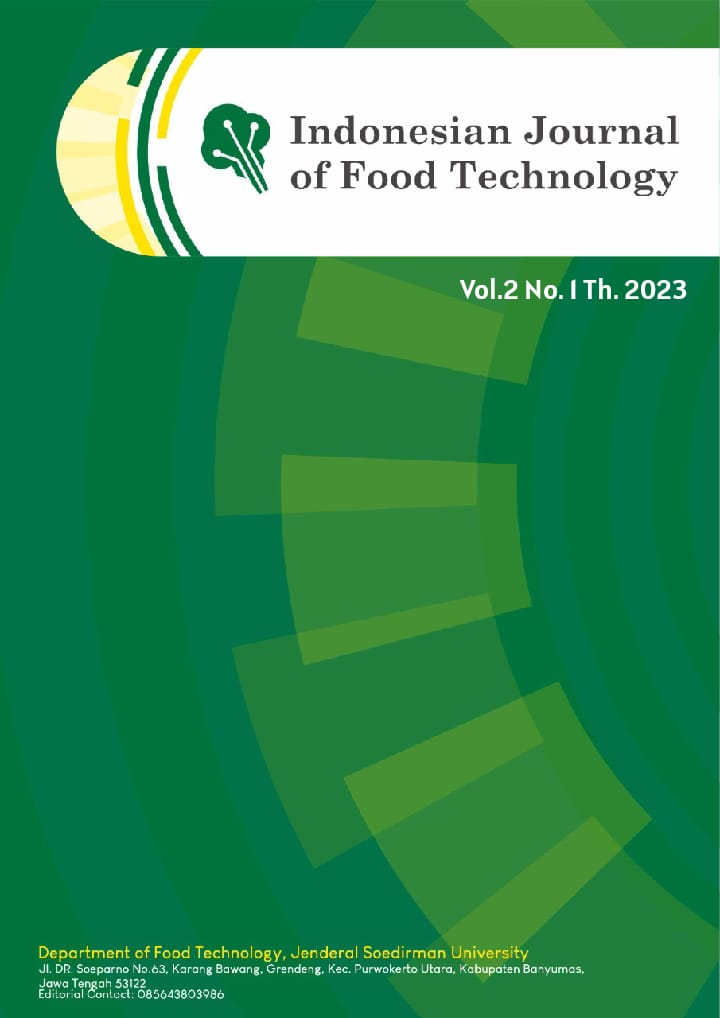Chemical and Organoleptic Characteristics of Cocoa Powder from Fermented and Unfermented Cocoa Beans from Masni District and Sidey in Manokwari Regency
Abstract
beverage industry, such as chocolate drinks and ingredients for cakes, puddings, and ice cream. The fermentation process of cocoa beans is one of the determining factors for the quality of cocoa powder products produced. This is because during the fermentation process, physical, chemical, and organoleptic characteristics are formed, which become the standard for high-quality cocoa powder products. One of the factors that influences the success of the cocoa bean fermentation process is the fermentation time. The right fermentation time is expected to produce high-quality cocoa beans with a distinctive chocolate flavor, according to consumer preferences. The aim of this study was to determine the chemical, and organoleptic characteristics of cocoa powder from cocoa beans originating from Masni District and Sidey District with different fermentation times. The study consisted of six treatments: cocoa beans processed by the community (BKT), cocoa beans without fermentation (BKTF), cocoa beans fermented for 3 days (BK3), 4 days (BK4), 5 days (BK5), and 6 days (BK6). The differences between the treatments of unfermented cocoa beans and the fermentation time affect the physicochemical and organoleptic characteristics of the resulting cocoa powder. The fermentation process tends to improve the color of cocoa powder from dark brown to a lighter shade of brown, increase the moisture content, decrease the fat content, and significantly influence the organoleptic characteristics. Fermenting cocoa beans for 5 days results in cocoa powder with the best physical, chemical, and organoleptic characteristics. The organoleptic test of cocoa powder from cocoa beans fermented 5 days (BK5) show a slightly light brown to brown color, a strong to very strong cocoa powder flavor, a taste from less bitter to moderately bitter, and acidity levels from less acidic to moderately acidic.
References
Apriyanto, M. (2016). Changes in chemical properties of dried cocoa (Theobroma cacao) beans during fermentation. Intl. J. Food. Ferment, 5(1): 11-16.
Ariyanti, M., Ramlah, S., & Yumas, M. (2019). Pengaruh lama fermentasi dan pengepresan berulang terhadap mutu kakao bubuk. Jurnal Industri Hasil Pertanian, 4 (1): 21-27.
Camu, N., De Winter, T., Addo, S. K., Takrama, J.S., Bernaert, H., & De Vuyst, L. (2008). Fermentation of cooca beans: influence of microbial activities and polyphenol concentrations on the flavour of chocolate. J Sci Food Agric, 88: 2288-2297.
David, J.H., & Tommy, P. (2011). Pengaruh fermentasi biji kakao terhadap olahan coklat di Kalimantan Barat. Biopropal Industri, 2 (1): 20-26.
Direktorat Jenderal Perkebunan Kementerian Pertanian RI. 2021. Statistik Perkebunan Nasional 2020-2022. Jakarta.
Dinas Pertanian dan Ketahanan Pangan sedang berupaya kembalikan kejayaan kakao di Kabupaten manokwari. 2020. (internet). (diunduh 27 Juni 2023)). Tersedia pada: https://suaramandiri.co/dinas-pertanian-dan-ketahanan-pangan-sedang-berupaya-kembalikan-kejayaan-kakao-di-kabupaten-manokwari/
Djali, M., Setiasih, I. S., & Rindiantika, T. S. 2018. Chemical characteristics, phytochemicals and cacao shell toxicity during the processing of cocoa beans. Asian J Agri&Biol, 6(1): 103-114.
Kongor, J. E., Hinneh, M., De Walle, D. V., Afoakwa, E. O., Boeckx, P., & Dewettinck, K. (2016). Factors influencing quality variation in cocoa (Theobroma cacao) bean flavour profile—A review. Food Research International, 82, 44–52. https://doi.org/10.1016/j.foodres.2016.01.012
Lima, L.J.R., Almeida, M.H., Nout, M .J. R. N., & Zwietering, M H. (2011). Theobroma cacao L., “The food of the gods”: quality determinants of commercial cocoa beans, with particular reference to the impact of fermentation. Critical Reviews in Food Science and Nutrition, 51: 731-761
Misnawi, Jinap, S., Jamilah, B., & Nazamid, S. (2003). Effect of incubation and polyphenol oxidase enrichment on colour, fermentation index, procyanidins and astringency of unfemented and partly fermented cocoa beans. International Journal of Food Science and Technology, 38 :285-295.
Mulato, S., Widyotomo, S., & Nuraini H. (2004). Kinerja alat penghalus pasta cokelat tipe silinder berputar. Penelitian Perkebunan, 20: 37-53.
Nizori, A., Tanjung, O.Y., Ulyarti, U., Arzita, A., Lavlinesia, L., & Ichwan, B. (2021). Pengaruh lama fermentasi biji kakao (Theobroma cacao L.) Terhadap Sifat Fisik, Kimia dan Organoleptik Bubuk Kakao. Jurnal Pangan dan Agroindustri, 9(2): 129-138.
Oktarianti, D., & Rohmah, M. (2017). Pengaruh wadah dan lama fermentasi biji kakao (Theobroma cacao L). terhadap sifat kimia dan sensoris bubuk kakao. Jurnal Teknologi Pertanian Universitas Mulawarman, 12(2): 53-57.
Oberparleiter, S., & Ziegleder, G. (1997). Amyl alcohols as compouds indicative of raw cocoa bean quality. Z Lebensm Unters Forsch, 204: 156-160.
Rodriguez-Campos, J., Escalona-Buendia, H.B., Orozco-Avila, I., Lugo-Cervantes, E., Jaramillo-Flores, M. E. (2011). Dynamics of volatile and non-volatile compounds in cooca (Theobroma cacao L) during fermentation and drying processes using principal components analysis. Food Research International, 44: 250-258.
Saunsshia, Y., Sandhya, M.V.S., Lingamallu, J.M.R., Padela, J., Murthy, P. (2018). Improved fermentation of cocoa beans with enhanced aroma profiles. Food Biotechnology, 32(4): 257-272.
Sigalingging, H.A., Putri, S., H., & Iflah, T. (2020). Perubahan fisik dan kimia biji kakao selama fermentasi. Jurnal Industri Pertanian, 2(2): 158-165).
SNI (Standar Nasional Indonesia). (2013). Kakao Bubuk. SNI 3747:2013. Jakarta: Badan Standarisasi Nasional.

This work is licensed under a Creative Commons Attribution-ShareAlike 4.0 International License.










